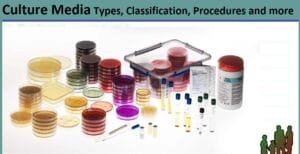1. Introduction to Microbiology and Culture Media
Microbiology is a branch of science that focuses on microorganisms, which include bacteria, viruses, fungi, and protozoa. Understanding and cultivating these microorganisms are vital for diagnosing diseases, conducting research, and industrial applications. Culture media serve as the foundational tools in this process, providing nutrients and an appropriate environment for microbial growth.
In this section, we’ll explore the role of culture media in microbiology and discuss why it is indispensable in diagnostics, pharmaceutical development, and food safety testing.
2. Classification of Culture Media
Culture media can be classified based on their physical state, composition, and function. This classification helps scientists choose the appropriate medium for specific purposes.
Based on Consistency
- Solid Media: Contain agar as a solidifying agent and are ideal for isolating colonies. Examples: Nutrient Agar, MacConkey Agar.
- Liquid Media: Lack a solidifying agent and are used for growing large volumes of microbes. Examples: Nutrient Broth, Tryptic Soy Broth.
- Semi-Solid Media: Contain less agar than solid media and are used to assess motility. Example: Sulfide Indole Motility (SIM) medium.
Based on Composition
- Synthetic (Defined) Media: Composed of known quantities of specific chemicals. Example: Minimal Media.
- Complex Media: Contain ingredients like yeast extract or peptones, whose exact composition is unknown. Example: Brain Heart Infusion (BHI) Broth.
Based on Function
- Selective Media: Promote the growth of specific organisms while inhibiting others. Example: Mannitol Salt Agar (for Staphylococci).
- Differential Media: Differentiate between organisms based on metabolic characteristics. Example: MacConkey Agar (lactose fermenters vs. non-fermenters).
- Transport Media: Preserve specimens during transport to labs. Example: Cary-Blair Medium.
- Enrichment Media: Enhance the growth of particular microbes. Example: Selenite F Broth (for Salmonella).
3. Detailed Charts and Tables
A comprehensive chart simplifies the classification and usage of culture media. Here’s an example:
| Medium Type | Example | Key Use |
|---|---|---|
| Nutrient Agar | General-purpose medium | Growth of non-fastidious organisms |
| Blood Agar | Enriched and Differential | Hemolysis testing for Streptococcus species |
| MacConkey Agar | Selective and Differential | Isolation of Gram-negative enteric bacteria |
| Sabouraud Dextrose Agar | Fungal growth | Cultivation of yeasts and molds |
These charts provide an at-a-glance view of how specific media are applied in practice.
4. Key Culture Media and Their Uses
Each culture medium is tailored for a specific set of microorganisms. Below are some widely used media:
- Nutrient Agar: A general-purpose medium used in labs for routine microbial growth.
- MacConkey Agar: Designed to isolate Gram-negative bacteria and differentiate lactose fermenters.
- Blood Agar: Enriched with sheep blood, it helps identify hemolytic activities of bacteria.
- Thayer-Martin Agar: A selective medium for isolating Neisseria species.
- Sabouraud Dextrose Agar: Favors fungal growth due to its acidic pH.
Each medium has unique properties, making it indispensable for microbiological studies and diagnostics.
5. Step-by-Step Preparation Guidelines
Proper preparation of culture media ensures reliable and reproducible results. The general steps are:
- Measure Ingredients: Follow the manufacturer’s instructions or scientific recipes.
- Dissolve Components: Use distilled water and heat gently to dissolve powders completely.
- Sterilization: Autoclave at 121°C for 15 minutes to eliminate contaminants.
- Dispense into Containers: Pour into sterile Petri dishes or tubes as needed.
- Allow Solidification: Let the medium cool and solidify if it contains agar.
Quality control testing ensures the medium supports intended microbial growth without contamination.
6. Applications in Diagnostics and Research
Culture media play critical roles in medical diagnostics, scientific research, and industrial processes:
- Clinical Diagnostics: Detecting pathogenic bacteria like E. coli, Staphylococcus aureus, or Mycobacterium tuberculosis.
- Pharmaceutical Testing: Assessing sterility and microbial contamination in drugs.
- Food Safety: Testing for pathogens like Salmonella or Listeria.
- Environmental Microbiology: Monitoring water quality and soil health.
7. Troubleshooting and Best Practices
Even experienced microbiologists face challenges in using culture media. Here are some common problems and solutions:
| Problem | Cause | Solution |
|---|---|---|
| Contamination | Non-sterile technique | Improve aseptic handling |
| Inconsistent Results | Incorrect preparation or storage | Review protocols and expiry dates |
| Poor Microbial Growth | Nutrient deficiencies or wrong pH | Optimize medium composition |
Implementing good laboratory practices, such as routine sterilization and proper storage, can minimize these issues.
8. Conclusion
The microbiology culture media chart is an essential tool for anyone working in microbiology, whether in a clinical, academic, or industrial setting. It provides a systematic way to understand the myriad of media types and their applications. By mastering the use and preparation of culture media, scientists and healthcare professionals can enhance their diagnostic accuracy and contribute to significant advancements in microbial research.
Would you like me to expand on any specific section or integrate additional examples?



